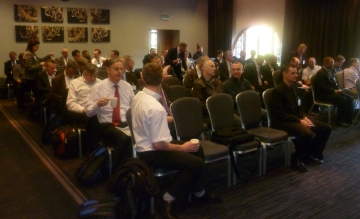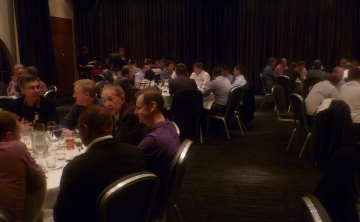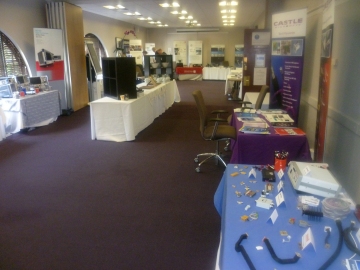The April 2012 meeting was a complete sell-out. The technical presentations are listed below. The best paper prize was won by Charles Suckling of TriQuint Semiconductors. This meeting saw the start of the young engineer sponsorship scheme. Any young engineers (28 or below) who have papers accepted are sponsored to attend as a delegate free of charge and receive a ?100 sponsorship award. Two of the speakers listed below received this sponsorship.
 |  |  |
Milton Hill House
Steventon
Oxfordshire
OX13 6AF
| Tel | 0870 609 1153 |
| Web | http://www.deverevenues.co.uk/locations/milton-hill-house.html |
John Kitchen
SJ Technologie
Affordable Phased Array Weather Radars; starting to become reality | |
| Prof. David McLaughlin | |
| University of Mass at Amherst | |
This paper discusses several approaches being taken to realize affordable phased arrays to enable future networks of dense radars. We discuss the driving design considerations behind such a technology and present recent academic laboratory and commercial development successes aimed at achieving “phase-phase” and “phase-tilt” antenna designs. | |
| Affordable Phased Array Weather Radars; starting to become reality | |
Automated Characterisation of a Super Low Noise InGaAs HEMT at X- & Ku-Band | |
| Mike Casbon | |
| Cardiff University | |
This paper describes a process developed at Cardiff University for extracting the noise figure and gain contours for packaged low noise devices. Specially developed software is used to control an automated source tuner and record the results over a user defined area of the Smith chart. Full 3D EM simulation is used to de-embed the device from the measurement fixture. | |
| Automated Characterisation of a Super Low Noise InGaAs HEMT at X- & Ku-Band | |
Design of High Efficiency, Multi-Octave Microwave Push-Pull Power Amplifiers (young engineer sponsored paper) | |
| Robert Smith | |
| Cardiff University | |
Using differential linear measurements, the harmonic impedance conditions presented by simple transmission line baluns are identified. These impedances are shown to differ significantly from the short-circuit harmonic conditions usually associated with push-pull amplifiers. When taking into account these impedance conditions, a family of waveforms corresponding to the theoretical waveforms inside a push-pull amplifier can be described mathematically and measured using a harmonic load-pull system. The wideband nature of transmission line baluns can be utilised to design and build push-pull microwave power amplifiers that can operate over multiple octaves and at higher efficiencies than conventional wideband amplifiers. This concept has been demonstrated through the design and test of a push-pull PA utilising packaged GaN HEMTs. | |
| Design of High Efficiency, Multi-Octave Microwave Push-Pull Power Amplifiers (young engineer sponsored paper) | |
Design of High Power and Efficient RF LDMOS PA for ISM Applications | |
| Farhat Abbas and John Gajadharsing | |
| NXP Semiconductors | |
Very high performance in power and efficiency radio frequency (RF) laterally diffused MOS (LDMOS) Class AB power amplifier (PA) designed, prototyped and tested for industrial, scientific, medical (ISM) applications at 2.4 GHz-2.5 GHz. | |
| Design of High Power and Efficient RF LDMOS PA for ISM Applications | |
Diamond Field Effect Transistors (young engineer sponsored paper) | |
| Stephen Russell | |
| University of Glasgow | |
Due to its superior material qualities such as high breakdown field (10 MV/cm), high carrier saturation velocity (1-3 x 10^7 cm/s) and large thermal conductivity (>2000W/mK), diamond is deemed the ideal material for providing future high power / high frequency electronic components. Using hydrogen-terminated diamond, various gate length field effect transistors have been fabricated at the University of Glasgow, the smallest with a gate dimension of 80nm. This has resulted in a record cut-off frequency of 55 GHz, the highest yet reported for a diamond based transistor | |
| Diamond Field Effect Transistors (young engineer sponsored paper) | |
Doherty, LINC and ET GaN HEMT PA Design | |
| Ray Pengelly | |
| Cree | |
Doherty, Chireix Outphasing and Envelope Tracking PA Design with Examples | |
| Doherty, LINC and ET GaN HEMT PA Design | |
| Doherty, LINC and ET GaN HEMT PA Design - part 2 | |
High Power Testing of Low Loss Components utilising Resonant Ring Structures | |
| Keith Newsome | |
| E2V Technologies | |
Focusing primarily on the testing of a high power isolator for 100kW industrial processing systems, this paper will detail the design methodology employed for resonant ring construction. Additional information gained from testing using resonant rings will be included together with a discussion of the error margins associated with the measurements. Use of ring structures to extend test capability, and de-risk of component breakdown events is also discussed. | |
| High Power Testing of Low Loss Components utilising Resonant Ring Structures | |
Inline RF Signal Processing: Customising Measurements and Analysis with Off-the-Shelf FPGA Technology | |
| Jeremy Twaits | |
| National Instruments | |
| Implementing continuous software-defined radio systems requires large amounts of real-time, inline processing. With a standard PC-based architecture, it is difficult to achieve the processingspeeds and data transfer rates required, so it is necessary to look to other computing nodes, such as DSPs or FPGAs. Throw in the need to test and measure MIMO-based standards, like 802.11ac (WLAN) and the amounts of data requiring analysis can become overwhelming. In this session, we shall discuss techniques for using FPGAs to perform inline signal processing for software-defined radio and MIMO-based wireless standards. | |
Linear, Switching and Waveform Engineered GaN HEMT PA Design | |
| Ray Pengelly | |
| Cree | |
Linear, Switching & Saturated Power Amplifier Designs with Examples. | |
| Linear, Switching and Waveform Engineered GaN HEMT PA Design | |
Low Temperature Microwave Irradiation as an Activator of Biomass Pyrolysis | |
| Mario De bruyn | |
| University of York | |
Biomass can be seen as the oil well of the future; a renewable and widely distributed resource that should be increasingly exploited for the production of energy products with environmental, economic and social benefits. One method by which the bio-energy carriers and chemicals can be obtained is pyrolysis. The latter is a feedstock agnostic technique capable of deconstructing biopolymers into more useful gas, oil, chemical and char products. Microwave irradiation can interact with different types of biomass at low temperature compared to conventional flash pyrolysis. Building on our original work in microwave pyrolysis and bio-refining, studies are now underway dealing with ligno-cellulosic compounds and whole biomasses, mechanistic & process conditions, product analysis and scale-up. | |
| Low Temperature Microwave Irradiation as an Activator of Biomass Pyrolysis | |
Monolithic Integration of RF MEMS and GaAs MMIC process for RF sensing applications | |
| B. Grandchamp | |
| OMMIC | |
This paper shows the promising results of the integration of low-loss and high isolation RF MEMS switch in OMMIC GaAs MMIC process line. This technology has been used to design building blocks (such as reconfigurable impedance matching network for reconfigurable LNAs) targeting phased arrays applications. This work is part of the FP7 EU-project MEMS-4-MMIC. | |
| Monolithic Integration of RF MEMS and GaAs MMIC process for RF sensing applications | |
New Qualified Industrial 0.5?m AlGaN/GaN HEMT Process: Status on GaN development | |
| Didier Floriot | |
| UMS | |
This paper describes the performances of a new power 0.5 μm gate length AlGaN / GaN HEMT process named GH50_10. This process has been developed to address applications and market needs up to 7 GHz. A specific emphasis has been attached to find a trade- off in between power / efficiency and linearity . After an introduction of the context, a short description of the process manufacturing is given including spread of the DC parameters. From the qualification procedure, key reliability figures of the process are presented like the main energy of activation and an evaluation of the Median Time to Failure, evaluated respectively to 1.95ev and 106 hours at 200°C. Power performances are presented from L to C bands from 15W for the elementary power transistors to 50W for high power packaged transistors. This technology is presently available at industrial level to address products requirements for telecom and military needs. Finally, a status is presented concerning the development of a 0.25μm gate length process which is on the way to enter in qualification process. | |
| New Qualified Industrial 0.5?m AlGaN/GaN HEMT Process: Status on GaN development | |
RF & Microwave Solid State Power Amplifier Design is a Speciality | |
| Ivan Bozhnakov | |
| Amplifier Technology | |
| - | |
| RF & Microwave Solid State Power Amplifier Design is a Speciality | |
Symbiosis: Measurement & Simulation in Modern Device Design | |
| Dr. Marc Rütschlin | |
| CST | |
In the last two decades, virtual prototyping by electromagnetic simulation has assumed an increasingly central role in product design and the RF engineer's daily work. The benefits of simulation in accelerating the design cycle, thus reducing cost and time-to-market, are undeniable. But for simulation to be used with confidence requires trust in the accuracy of the results it delivers. Engineers must know that the predictions made by simulating their virtual model will correspond to their measurements of an actual prototype device. | |
| Symbiosis: Measurement & Simulation in Modern Device Design | |
Thermal Analysis of GaN Devices | |
| Charlie Suckling | |
| TriQuint Semiconductor | |
| - | |
| Thermal Analysis of GaN Devices | |
As always there will be an accompanying commercial exhibition. Companies interested in exhibiting should email exhibition@armms.org
Contributions are invited with an emphasis on RF and microwave design, research, testing and associated subjects. An oral presentation will be made at the meeting and a written paper will be required for publication in the society digest, which is distributed to delegates at the meeting. Prospective speakers are requested to submit a title and a short abstract to the technical coordinator (see above) as soon as possible.
Click here to view our Guidelines for Authors
Click here to view our Publication Release Form